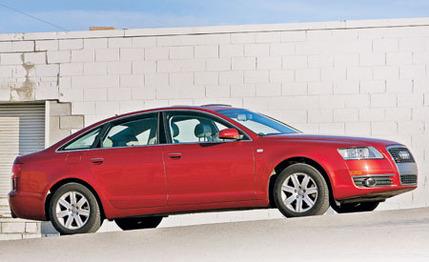
 Long-Term Road Test
Long-Term Road Test
When the sixth-generation Audi A6 (we're counting 5000s and 100/200s to be parts of the A6 family) arrived in the U.S. at the end of 2004, we were busy with the lusty V-8 A6 Quattro 4.2. After road and comparison tests of the 335-hp V-8 version, it would have appeared to our readers that we were ignoring the less-powerful V-6 version. We weren't. In fact, we ordered a 2005 A6 3.2 Quattro for our long-term test fleet to shake down Audi's new direct-injection V-6 over 40,000 miles.
The 3.1-liter V-6 (it's also available in the smaller A4) is a heavily revised version of Audi's earlier 3.0-liter and 2.8-liter all-aluminum 60-degree V-6 engines. To avoid confusion, we should mention that Audi calls it a 3.2-liter, but it is, at 3123 cubic centimeters, a 3.1-liter engine. It may seem as if the new six's four valves per cylinder are a retrograde step versus the five-valve-per-cylinder arrangement of the 3.0-liter that preceded it, but the new engine gets Audi's direct fuel-injection system (FSI) that allows a staggering 12.5:1 compression ratio; the previous six had a 10.0:1 compression ratio. With an additional 147 cubic centimeters of displacement and the extra squish in the combustion chamber, the direct-injection six puts out 255 horsepower at 6500 rpm (35 more horses than previously) and 243 pound-feet of torque at an easily accessible 3250 rpm. Incidentally, the new six has five more horsepower than the discontinued 2.7-liter twin-turbocharged V-6 that used to bridge the gap between the base V-6 and the V-8.
Our Canyon Red A6 3.2 Quattro arrived in the spring of 2005, and we admired the handsome interior and exterior styling, despite its unfashionably small 16-inch alloy wheels. We chose the smaller wheels because of our experience with the Sport package on V-8 A6s. The package's 18-inch wheels look great, but the firm suspension and large wheels lead to a hard ride. We should have opted for the stand-alone 17-inch wheels, which we felt would have been a nice compromise between style and ride comfort. For 2006, A6s equipped with Quattro all-wheel drive get 17-inch wheels standard - base front-wheel-drive A6s soldier on with the 16-inchers. Other options on our tester included a navigation system ($1500), premium leather upholstery ($1000), rear parking sensors ($350), and a Premium package of sunroof, xenon headlights, Bose stereo, and wood interior trim ($3000). We didn't tick off the heated-seat option, and when winter arrived, we regretted that decision. The A6 totaled $51,770, which is a couple grand less than a comparably equipped 2006 A6 would cost.
Despite the diminutive wheels, the A6 ran up an impressive 4500 miles in its first month. Before we knew it, the car's computer was demanding a service stop, at 5000 miles. During that visit, complaints about clicking noises coming from the engine were found to be part of the normal operation of the FSI. Stand outside an idling A6 3.2, and the engine ticks as the high-pressure injectors spray into the cylinders. We've noticed that Volkswagen and Audi's other FSI engine, the 2.0-liter turbo four in the A3 and GTI, makes a similar sound while idling. We drove off from the dealership without paying a penny for our service; at the time, Audi didn't charge for scheduled maintenance during the four-year/50,000-mile warranty period - but Audi is dropping the free service for 2007. After that first stop at 5000 miles, the A6 required service every 10,000 miles. Since we didn't pay for any of the stops, we saved about $800 over 40,000 miles.
As a highway cruiser, our A6 was a favorite among staffers. Logbook entries paid tribute to the comfortable seats, supple ride, quiet and beautifully crafted cabin, and 21.1-gallon tank that allows nearly 500 miles before needing a refill. Over 40,000 miles, we averaged 23 mpg. It wasn't long before the A6 required a 15,000-mile service. No problems were reported, and after an oil change and thorough inspection, we were sent on our way.
Actually, the A6 had started to draw some criticism, but it was nothing the dealer could fix. Gripes about the distracting iDrive-like single-knob controller, dubbed Multi Media Interface, began to fill the logbook. Audi's interpretation of a complicated and we think unnecessary idea adds buttons next to the controller knob to directly access different menus (radio, navigation, vehicle settings). However, we have to concede that the single-knob system does in fact perform complicated tasks fairly well. For example, entering a destination into the optional navigation system is remarkably intuitive. However, seemingly simple tasks such as tuning the radio, setting station presets, or cycling through the optional ($550) Sirius satellite radio stations require a multitude of distracting, aggravating steps.